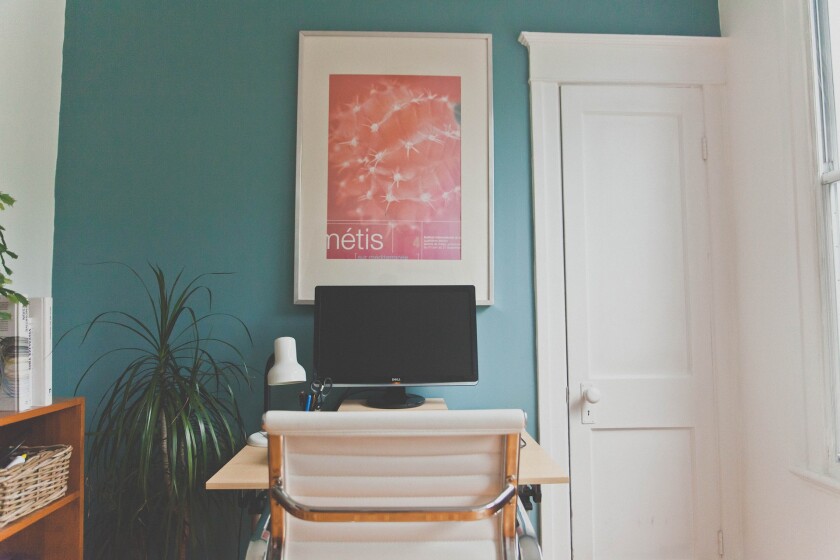Tips for Navigating the Transition to Working from Home

Due to building closures during the COVID-19 quarantine, many of us are transitioning to working remotely. This can present unique challenges and anxieties, such as balancing household responsibilities with office tasks, privacy, and staying motivated. There can also be unexpected benefits, however, like no commute time, working in pajamas, easy access to food and other comforts, and spending more time with family. There are several things we can do to make our work life run more smoothly in this uncertain time.
Work Space
Although working at home will feel different from going into the office, we can do things to make our work areas more useful.
- Defined space
- Eliot Bliss has been working remotely as a Bilingual Customer Support Representative for JetBlue for nearly a decade. One thing that has helped him is having a “clearly defined work space. I have worked in a closet, an attic, a basement, and even my bedroom …. All of these spaces were clearly defined, which let me ‘separate’ myself mentally, if not always physically from the rest of my home.”
- John R. Amatangelo, Senior Sales Executive for Fidelity Information Services, has worked remotely for over three years. He also recommends having a separate area as your office, “whether it’s a bedroom or a corner of a room that can be blocked off.”
- Comfortable area
- Both Eliot and John emphasize that it is important to make your defined space comfortable, so that you want to work there. It is helpful to have a comfortable chair and tools you need for work within easy reach.
- I have found that the lighting in my work space is important to me. I prefer lamps rather than a bright overhead light and being in a space where I can see some natural light helps my sense of well-being.
Prioritizing
Minimizing distractions and staying on task while working at home can be challenging. There will always be children or others in your household who would like your attention, chores that you want to get done, things to look at on the internet or social media, shows to watch—the list goes on.
- Task lists
- Michael Whitchurch, Digital Learning Services Librarian at Brigham Young University, advises creating a list of tasks to accomplish with “due” dates. “This helps me focus on the things that need to be done first.”
- Emily Darowski, Psychology Librarian at Brigham Young University, suggests setting a timer for 30-45 minutes to work on a specific item. This can help put your focus on the work and lessen distractions. She also feels it is beneficial to “set priorities each morning and ‘check in’ with yourself after work.” Creating a list and checking things off can provide a sense of accomplishment each day.
- Setting a schedule
- Eliot says, “…if you can establish a set schedule, and stick to it, it becomes much easier to motivate yourself …. This will also help those around you … to avoid you during your work hours.”
- John adds, “Make sure children and others know that they can’t bother you during work unless it’s an emergency.” He also says that having “easy access to a bathroom where no one can bother you” is helpful. Defining clear work time boundaries with others is crucial to success.
Breaks
Taking breaks is key for maintaining mental focus.
- Get up and move
- Emily recommends walking some laps around the house when you get up for a drink. Even if you just get up to use the restroom, eat some lunch, or take a short walk, regular mental breaks will help your productivity.
- Schedule break time
- John suggests scheduling in breaks to eat and check on family members. It is easy to get caught up in work and forget to take breaks, which can lead to extra stress.
Physical Tools
Having the tools you need to do your job effectively is essential to success. Consider items you may need other than your computer and phone that you take for granted in your office building, such as the following:
- Post-its
- Writing utensils
- Notebooks
- Whiteboard and dry erase markers
- Water bottle
- Tissues
- Hand sanitizer
- Lamps and other décor
Staying Connected
Social distancing protocols have negated physical meetings, so it is important to utilize online tools to stay connected with colleagues. The applications listed below are currently offering free services due to the number of people working remotely because of COVID-19.
- Zoom
- Zoom is an online tool for hosting meetings, video webinars, conference calls, and online chats. It can be used on a computer, tablet, or phone. Brigham Young University currently has a Zoom subscription for employees and students.
- G Suite
- G Suite is a Google application that connects tools like Gmail, Google Docs, Google Drive, Google Calendar, and Google Meet for business.
- Microsoft Teams
- Microsoft Teams has options for group chats, calls, and video conferencing and is conducive to collaboration with Office 365 applications like Word, Excel, and PowerPoint.
- Skype
- Skype allows for audio and video calling, smart messaging, call recording and live subtitles, offline phone calls, and private conversations with encryption.
- Webex
- Webex provides video conferencing, app sharing and integration, and several device options for staying connected.
This is an unprecedented time in the world, but we can get through it together and stay connected while working remotely. Please stay home, stay safe, and wash your hands.
Ellen Amatangelo is the Scholarly Communications Coordinator for the Harold B. Lee Library at Brigham Young University. For questions about scholarly communications or help with scholarly publishing and research, please email ellen_amatangelo@byu.edu. To read and download scholarly works produced by BYU faculty, staff, and students, please visit https://scholarsarchive.byu.edu/.